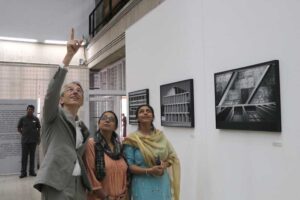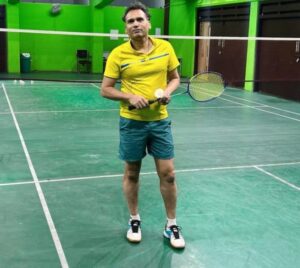Emmanuel Lenain, the Ambassador of France to India, is not only a celebrated diplomat but also an avid photographer with a keen eye for capturing the beauty of architecture. His ongoing photography exhibition, titled ‘Tender Concrete,’ at the Chandigarh Government Museum and Art Gallery showcases his artistic passion for concrete architecture. The exhibition is open for public viewing from April 18 to June 30, except on Mondays and gazette holidays, between 10 am to 4:30 pm.
In an exclusive interview, we will delve into Emmanuel Lenain’s photography journey, his creative process, and the inspiration behind his ongoing exhibition. Join us as we uncover the world of photography through the eyes of a diplomat!
 Tell us a little about your pursuit of photography. When and how did it start?
Tell us a little about your pursuit of photography. When and how did it start?
I was not born with a camera or a precocious photographer as the brilliant Jacques-Henri Lartigue. I hated the poor quality photographs that filled family albums in my childhood. I discovered real photography through the process of printing silver gelatin prints in my early twenties. The progressive and almost miraculous formation of the image in the developing bath was such a delight! This technical training taught me a lot about the role of light that ultimately is the sole actor of photography.
Your ongoing photography exhibition Tender Concrete is seen to be much celebrated by the photography and architecture enthusiasts in Tricity. Tell us more about it?
India has been a formidable field for modernist architecture. Nowhere except maybe in Brasilia with Oscar Niemeyer has carte blanche been given to an architect to build a full city from scratch as Le Corbusier did in Chandigarh. That’s why I wanted to devote an exhibition only to these buildings. I did not want to follow the documentary genre but a personal subjective approach. A photograph of architecture is not necessarily a topographical survey: it can be the expression of an emotion. I am less interested in the buildings taken as a whole than in architectural details which, taken out of their context, acquire a poetic dimension.
What is the story behind the title ‘Tender Concrete’?
I am not among those left aghast by Brutalism. Quite the contrary: concrete, when handled by the greatest architects, has always seemed tender to me. It allows for sensual and dizzying curves, the alternation of empty and full, a plunge into solitude and reverie. Concrete allows for a constant, almost musical tension: rectangle contrasts with curve, sharp edges with softened profiles, static with fluid, rest with movement. Here and there, buildings of strict verticality and horizontality contrast with the freedom of a curved ramp. And, as often in the case, a certain harmony emerges from opposites.
Who is your source of inspiration in terms of photography?
I like patterns, geometry, structures, shapes above all. All in Black and White. I always say that it is like for music: some people like Bach, others prefer Tchaikovsky; or for graphic arts: some prefer drawing to painting, lines to colours. So, the absolute master could be Henri Cartier-Bresson but I take a lot of inspiration from India where the photography scene is so vibrant! I did a book with Raghu Rai two years ago to cross our visions of each other’s country and now as my photography turns slightly more introspective and meditative, I am very attracted to Dayanitha’s Singh work.
 How do you strike a balance between your role as an Ambassador and a passionate photographer?
How do you strike a balance between your role as an Ambassador and a passionate photographer?
I try to prevent photography from totally taking over! Seriously, the two activities are highly complementary. Photography pushes me to dig deeper into the countries I am posted to, go to unusual places but also look beyond the obvious, be attentive to details I would otherwise not notice, understand the source of certain emotions that run through me and keep a record of them.
One final message for our readers.
Go and see the exhibit! Photography is a very physical, almost sensual medium. It has a tone, grain, and texture. The light dances on the paper. One cannot enjoy it fully on a screen.
His work can be seen on Instagram: emmanuel_lenain







Comments are closed.